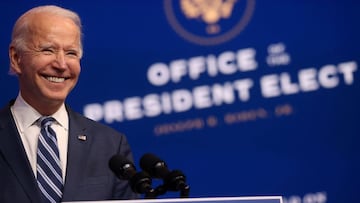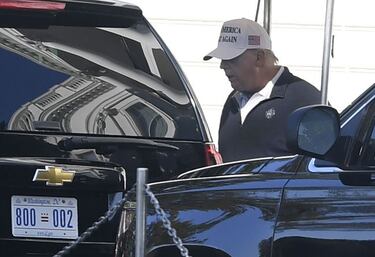Presidential inauguration: when will Joe Biden take over the White House?
The transition to Biden's White House is still stalling over Trump's lack of concession. Normally the process is broken into three phases over one year.

In the world’s longest standing democracy, the peaceful transition of power after a new president has been elected has been a trouble-free process since George Washington first handed over the presidency to his successor, John Adams, in the late 1700s.
But this time things are looking different with President Donald Trump still refusing to concede that he has lost the election over a week later and mounting a series of failing legal challenges in several states on the back of baseless claims of election fraud.
When is Joe Biden's presidential inauguration?
After being declared the winner of the 2020 US elections last weekend, Joe Biden is set to be inaugurated on 20 January, 2021 as the 46th president of the United States.During the intervening 63 days, the transition process will likely move ahead whether Donald Trump is willing to accept that process or not. Biden is, however reliant upon Trump's administration to cooperate in his transition, giving access to classified information including national security briefings, which has yet to be granted.
“The transition is moving ahead.” Ron Klain says on his first interview as Joe Biden’s Chief of Staff. “As time passes, the need to get the full access we are entitled to, and the full access that the American people want us to have—it grows each day.” https://t.co/2G1LsWtDKE
— MSNBC (@MSNBC) November 13, 2020
One business week has now passed since the Democrat was declared winner of the election. Today, Ronald Klain, Biden's newly elected White House chief of staff spoke to NBC Meet the Press, warning that the greater risks of delaying transition access include national security and the coronavirus pandemic. Klain said that the federal government needs to sign off on transition team efforts this week.

While it may seem like 20 January is still a long way away, if you've got a growing to-do list that includes, on top of the run-of-the-mill running a country, mounting a response to a global health crisis, economic crisis, climate crisis and a fractured society at home, every waking hour is precious to ensure Biden's smooth transition.
When does the transition to Biden's administration begin?
Planning and preparation actually began two and a half years ago by the nonpartisan federal employees who oversee the whole process. Trump and Biden’s campaigns then became involved in the process in May once Biden won the primary. This step is required by the Presidential Transition Act of 1963, with the president’s administration stipulated by law to establish a “White House transition coordinating council” to facilitate the process in preparation of Biden’s potential election.
That process is said to have gone well up to this point, with the council having so far met all necessary deadlines on updating Congress on its progress. Now that Biden has been elected, his incoming transition team will be tasked with overseeing the hiring of more than 4,000 government appointees, preparing policy plans and initiating their execution, as well as organising logistical tasks such as setting up offices.
What's involved in the transition process?
According to Presidential Transition Guide published by the Center for Presidential Transition (CPT), the main goals of the transition for a new president are as follows:
- Staffing the White House and the Executive Office of the President, developing a functional decision-making process and preparing to assume governing responsibility.
- Making more than 4,000 presidential appointments, more than 1,200 of which require Senate confirmation.
- Getting up to speed on more than 100 federal agencies and organizing and training leadership teams for each one.
- Building a policy platform for the new administration based on campaign promises, and planning executive actions, a management agenda, a budget proposal and potential legislation.
- Preparing a 100- to 200-day plan for executing the policies laid out during the campaign to help the new administration get off to a quick start.
Transition timeline: from Trump to Biden
The full transition process is broken into three phases: the pre-election “Planning” Phase, the Post-Election “Transition Phase” and the Post-Inauguration “Handover” Phase. These three phases cover roughly one year, from April and May of the election year though the new administration’s first 200 days in office.
Pre-election “Planning” Phase
During this phase, key transition team staff are assembled and organized, a project plan and goals are set, and relationships are established with Congress, the current administration, the General Services Administration, the Office of Government Ethics, the Federal Bureau of Investigation and the Office of Personnel Management.
Post-Election “Transition Phase”
Related stories
During the 75-day period between election and inauguration, the transition team handle the influx of campaign staff and prepare to take over the functions of government. As outlined by the Transition Guide, key activities in this phase include: "staffing the White House and agencies; deploying agency review teams to visit agencies; building out the president-elect’s policy and management agendas and schedule; and identifying the key talent necessary to execute the new president’s priorities."
Post-Inauguration “Handover” Phase
The main focus of this final phase of the transition is the vetting of staff and appointees based on the president’s top priorities, with new administration set to make around 4,000 political appointments.

